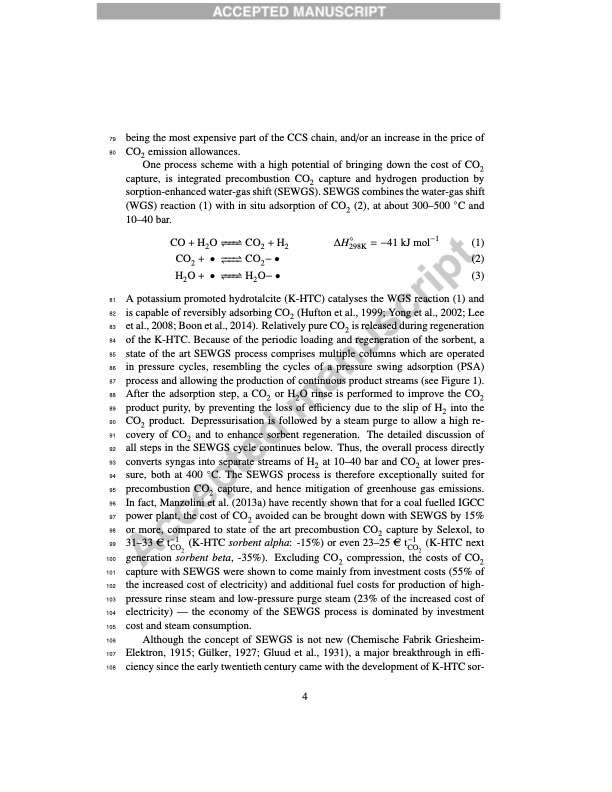
PDF Publication Title:
Text from PDF Page: 006
79 being the most expensive part of the CCS chain, and/or an increase in the price of 80 CO2 emission allowances. One process scheme with a high potential of bringing down the cost of CO2 capture, is integrated precombustion CO2 capture and hydrogen production by sorption-enhanced water-gas shift (SEWGS). SEWGS combines the water-gas shift (WGS) reaction (1) with in situ adsorption of CO2 (2), at about 300–500 ◦C and 10–40 bar. CO+HO−↽−−⇀−CO +H ∆H◦ 2 22 298K CO2 + • −↽−−⇀− CO2− • H2O + • −↽−−⇀− H2O− • =−41kJmol−1 (1) (2) (3) 81 A potassium promoted hydrotalcite (K-HTC) catalyses the WGS reaction (1) and 82 is capable of reversibly adsorbing CO2 (Hufton et al., 1999; Yong et al., 2002; Lee 83 et al., 2008; Boon et al., 2014). Relatively pure CO2 is released during regeneration 84 of the K-HTC. Because of the periodic loading and regeneration of the sorbent, a 85 state of the art SEWGS process comprises multiple columns which are operated 86 in pressure cycles, resembling the cycles of a pressure swing adsorption (PSA) 87 process and allowing the production of continuous product streams (see Figure 1). 88 After the adsorption step, a CO2 or H2O rinse is performed to improve the CO2 89 product purity, by preventing the loss of efficiency due to the slip of H2 into the 90 CO2 product. Depressurisation is followed by a steam purge to allow a high re- 91 covery of CO2 and to enhance sorbent regeneration. The detailed discussion of 92 all steps in the SEWGS cycle continues below. Thus, the overall process directly 93 converts syngas into separate streams of H2 at 10–40 bar and CO2 at lower pres- 94 sure, both at 400 ◦C. The SEWGS process is therefore exceptionally suited for 95 precombustion CO2 capture, and hence mitigation of greenhouse gas emissions. 96 In fact, Manzolini et al. (2013a) have recently shown that for a coal fuelled IGCC 97 power plant, the cost of CO2 avoided can be brought down with SEWGS by 15% 98 or more, compared to state of the art precombustion CO2 capture by Selexol, to 99 31–33 AC t−1 (K-HTC sorbent alpha: -15%) or even 23–25 AC t−1 (K-HTC next CO2 CO2 100 generation sorbent beta, -35%). Excluding CO2 compression, the costs of CO2 101 capture with SEWGS were shown to come mainly from investment costs (55% of 102 the increased cost of electricity) and additional fuel costs for production of high- 103 pressure rinse steam and low-pressure purge steam (23% of the increased cost of 104 electricity) — the economy of the SEWGS process is dominated by investment 105 cost and steam consumption. 106 Although the concept of SEWGS is not new (Chemische Fabrik Griesheim- 107 Elektron, 1915; Gu ̈lker, 1927; Gluud et al., 1931), a major breakthrough in effi- 108 ciency since the early twentieth century came with the development of K-HTC sor- 4PDF Image | High-temperature pressure swing adsorption cycle design for sorption

PDF Search Title:
High-temperature pressure swing adsorption cycle design for sorptionOriginal File Name Searched:
high-temperature-pressure-swing-adsorption.pdfDIY PDF Search: Google It | Yahoo | Bing
CO2 Organic Rankine Cycle Experimenter Platform The supercritical CO2 phase change system is both a heat pump and organic rankine cycle which can be used for those purposes and as a supercritical extractor for advanced subcritical and supercritical extraction technology. Uses include producing nanoparticles, precious metal CO2 extraction, lithium battery recycling, and other applications... More Info
Heat Pumps CO2 ORC Heat Pump System Platform More Info
| CONTACT TEL: 608-238-6001 Email: greg@infinityturbine.com | RSS | AMP |